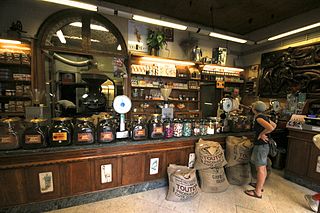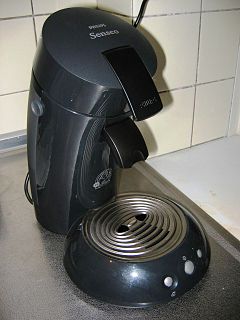
Espresso is a coffee-brewing method of Italian origin, in which a small amount of nearly boiling water is forced under 9–10 bars of pressure through finely-ground coffee beans. Espresso can be made with a wide variety of coffee beans and roast degrees. Espresso is the most common way of making coffee in southern Europe, especially in Italy, France, Spain, and Portugal. It is also popular in Switzerland, Croatia, Bosnia and Herzegovina, Bulgaria, Greece, and Australia.

Italians are well known for their special attention to the preparation, the selection of the blends, and the use of accessories when creating many types of coffees. Many of the types of coffee preparation known today also have their roots here. The main coffee port in Italy is Trieste where there is also a lot of coffee processing industry. Italian coffee consumption, often espresso, is highest in the city of Trieste, with an average of 1500 cups of coffee per person per year. That is about twice as much as is usually drunk in Italy.

Philips Saeco S.p.A., or short Saeco, is an Italian manufacturer of manual, super-automatic and capsule espresso machines and other electrical goods with headquarters and factories in Gaggio Montano near Bologna.

Gaggia is an Italian company that makes coffee machines, especially espresso and cappuccino machines, in addition to small kitchen appliances. The company is owned by Saeco International Group.

Senseo is a registered trademark for a coffee brewing system from Dutch companies Philips and Douwe Egberts. The system is known for the coffee pods it uses to brew the coffee.

Illycaffè S.p.A. is an Italian coffee company specializing in espresso, headquartered in Trieste. Illy markets its coffee globally in silver and red pressurized, oxygen-free cans; operates a network of cafes on shopping streets, in museums, and in airports; and, since 2009, has marketed a line of coffee-flavored energy drinks as illy issimo.

La Marzocco, founded in 1927, Florence, by Giuseppe and Bruno Bambi, is an Italian company specializing in high-end espresso coffee machines. It is based in Scarperia, with branch offices worldwide.

The Tassimo Hot Beverage System is a consumer single-serve coffee system that prepares one-cup servings of espresso, regular coffee, tea, hot chocolate and various other coffee drinks, notably those including milk such as latte or cappuccino. The brand is owned by JDE Peet's in most of the world and Kraft Heinz in North America.

The Caffitaly System is a capsule system for making espresso and other coffee drinks in home espresso machines. The name is a portmanteau of caffè, the Italian word for coffee, and Italy. Caffitaly is based in Bologna, Italy.

Luigi Lavazza S.p.A., shortened and stylized as LAVAZZA, is an Italian manufacturer of coffee products. Founded in Turin in 1895 by Luigi Lavazza, it was initially run from a small grocery store at Via San Tommaso 10. The business is currently administered by the third and fourth generations of the Lavazza family.
FrancisFrancis! is an espresso machine manufacturer owned by Illy. It was founded in 1994 by Francesco Illy. FrancisFrancis has produced espresso machines for the home market.

A single-serve coffee container is a method for coffee brewing that prepares only enough coffee for a single portion.

Bialetti is an Italian brand founded by Alfonso Bialetti that makes coffee machines, cookware and small kitchen appliances. The brand is owned by Bialetti Industries.
Emilio Lavazza (1932–2010) was an Italian businessman. Known as, "Mr. Espresso," he shaped the way many Italians drink their coffee and dedicated half of his lifetime to provide quality coffee globally. Lavazza served as the Chief and President of the Lavazza company. He served as President of Lavazza from 1979 until 2008.Throughout his lifetime, he had received much recognition such as, Honorary President prior to retiring his position in the Lavazza company. In 2010, Lavazza died due to a severe heart attack in Turin, Italy. The Lavazza company, today, is the sixth biggest coffee roaster with mustering over $1.1billion euros in sales. The company sells coffee in more than 90 countries after Emilio's reign as head of Lavazza.

The Easy Serving Espresso pod, is a small packed coffee pod with a paper filter covering for use in a non-grinding espresso machine. The E.S.E. standard was created by Italian Illy in the 1970s and is maintained by the "Consortium for the Development and the Protection of the E.S.E. Standard." It is open to all coffee roasters and machine manufacturers, making it the self-acclaimed "only open system available to the sector for espresso coffee prepared with paper pods".

The Nescafé Dolce Gusto is a coffee capsule system from Nestlé. The machines are produced by hardware manufacturers Arno from Næver, Krups and De'Longhi.

Coffee wars, sometimes referred to as caffeine wars, involve a variety of sales and marketing tactics by coffeehouse chains and espresso machine manufacturers to increase brand and consumer market share. In North America belligerents in these wars typically include large coffeehouses, such as Starbucks, Dunkin', McDonald's, and Tim Hortons. According to The Economist, the largest coffee war of the late 2000s was between Starbucks and McDonalds in the United States. The U.S. market has, since the early 2010s, been primarily contested by its two largest players, Starbucks and Dunkin'. Since 2020, competition over the Chinese coffee market has intensified between Starbucks and Luckin Coffee.

IperEspresso is a single-serve capsule system for preparing espresso coffee and espresso-based drinks. It is developed and patented by Illy.
Nestlé Nespresso S.A., trading as Nespresso, is an operating unit of the Nestlé Group, based in Lausanne, Switzerland. Nespresso machines brew espresso and coffee from coffee capsules, a type of pre-apportioned single-use container, or reusable capsules (pods), of ground coffee beans, sometimes with added flavorings. Once inserted into a machine, the capsules are pierced and processed, water is then forced against a heating element at high pressure meaning that only the quantity for a single cup is warmed. Nespresso is a premium price coffee, and by 2011 had annual sales in excess of 3 billion Swiss francs. The word Nespresso is a portmanteau of "Nestlé" and "Espresso", a common mechanic used across other Nestlé brands.

ISSpresso is the first espresso coffee machine designed for use in space, produced for the International Space Station by Argotec and Lavazza in a public-private partnership with the Italian Space Agency (ASI). The first espresso coffee was drunk in space by astronaut Samantha Cristoforetti on 3 May 2015. ISSpresso is one of nine experiments selected by the Italian Space Agency for the Futura mission.

















